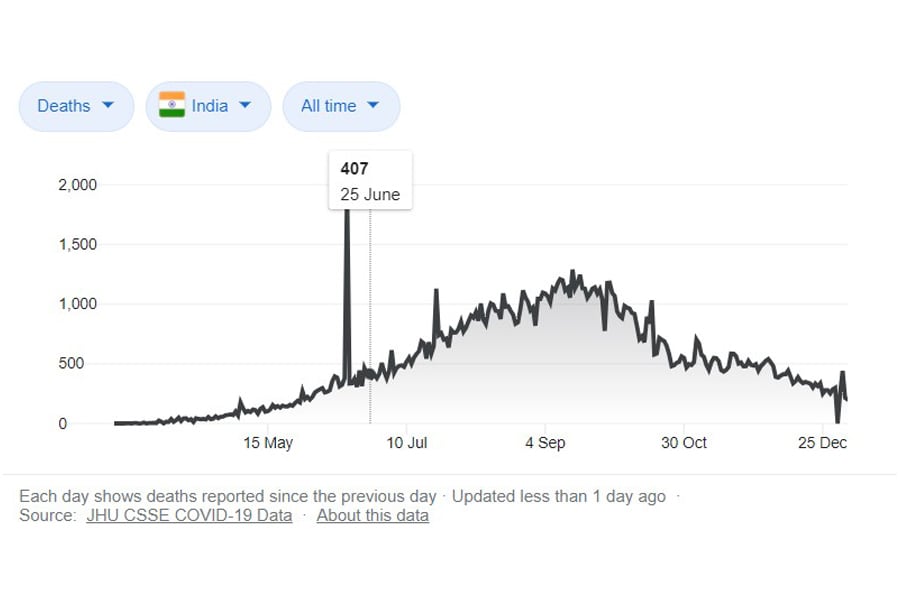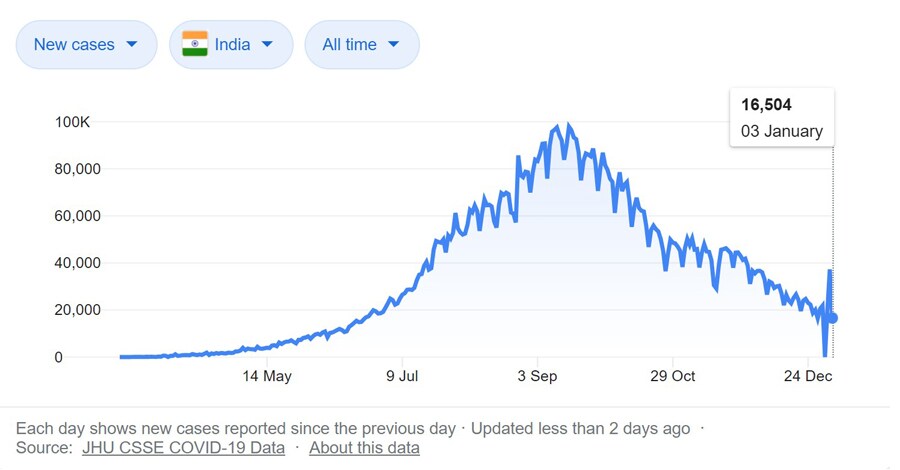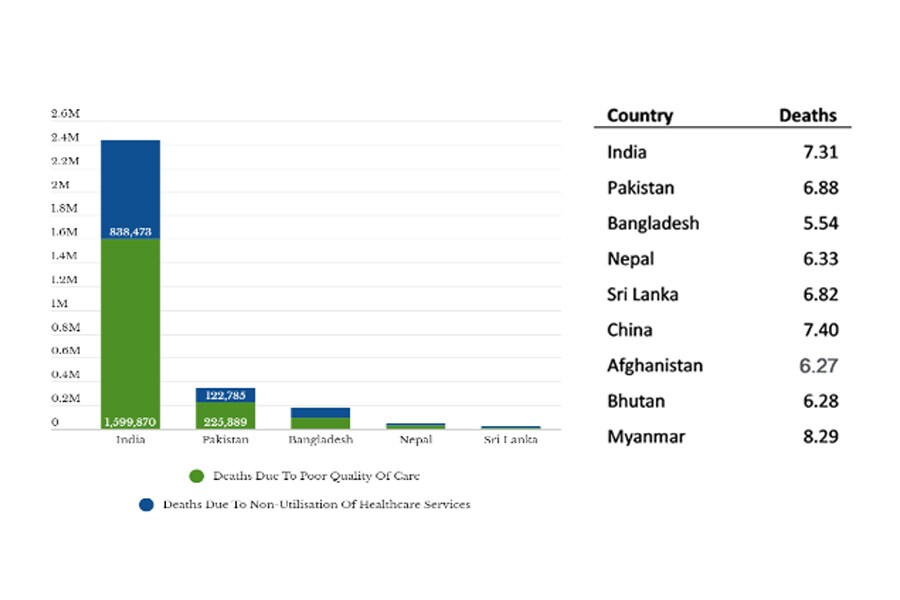Is government's frenzy for world's largest vaccination programme misplaced?
Public expenditure money should be used for improving overall medical infrastructure and reducing overall death rate in the country


 Image: Artur Widak/NurPhoto via Getty Images[br]The total number of registered deaths in India was 64,63,779 in 2017 and 69,50,607 in 2018 (when there was no Covid-19). A "quick and dirty" estimate of total number of (non-Covid-19) deaths in 2020 is 67,18,424 (see figure 1). I request the readers to not lose site of the forest while counting trees. Even a numerically challenged person would, I am sure, agree on the accuracy of the order of magnitude of the estimated number of deaths. For a 10-month period, estimated total number of (non-Covid-19) deaths in 2020 is 55,98,687.
Image: Artur Widak/NurPhoto via Getty Images[br]The total number of registered deaths in India was 64,63,779 in 2017 and 69,50,607 in 2018 (when there was no Covid-19). A "quick and dirty" estimate of total number of (non-Covid-19) deaths in 2020 is 67,18,424 (see figure 1). I request the readers to not lose site of the forest while counting trees. Even a numerically challenged person would, I am sure, agree on the accuracy of the order of magnitude of the estimated number of deaths. For a 10-month period, estimated total number of (non-Covid-19) deaths in 2020 is 55,98,687. [br]At the time of writing this article, the total number of reported deaths due to Covid-19 in India is 1,49,688. This number is approximately over a period of 10 months. Many so-called “conspiracy theorists” argue that several deaths, attributed to Covid-19, would have happened anyway, for instance, perhaps due to comorbidities or aging or any other reason not related to the pandemic. Even if we ignore the view of these conspiracy theorists, the number of Covid-19 deaths in India is 37 times lower than that due to other reasons.
[br]At the time of writing this article, the total number of reported deaths due to Covid-19 in India is 1,49,688. This number is approximately over a period of 10 months. Many so-called “conspiracy theorists” argue that several deaths, attributed to Covid-19, would have happened anyway, for instance, perhaps due to comorbidities or aging or any other reason not related to the pandemic. Even if we ignore the view of these conspiracy theorists, the number of Covid-19 deaths in India is 37 times lower than that due to other reasons. [br]Let us now look at number of daily new Covid-19 cases. On January 3, 2021, this number stood at 16, 504 (see figure 2). From figure 2, we see that daily new Covid-19 cases have been steadily falling. Therefore, it is reasonable to assume that despite uncertainty this number would be close to zero very soon. It will therefore not be irrational to infer that spread of Covid-19 infection will come to an end very soon.
[br]Let us now look at number of daily new Covid-19 cases. On January 3, 2021, this number stood at 16, 504 (see figure 2). From figure 2, we see that daily new Covid-19 cases have been steadily falling. Therefore, it is reasonable to assume that despite uncertainty this number would be close to zero very soon. It will therefore not be irrational to infer that spread of Covid-19 infection will come to an end very soon.
[br]I have written, in an earlier article, that number of yearly deaths in India due to other reasons such as malnutrition, tuberculosis, heart diseases are much greater than the deaths due to Covid-19 in 2020.
Notwithstanding this reality, the central government has rolled out the “world’s largest inoculation programme”. The media, as usual, has forgotten all other issues and have been spending all their time and space reporting this programme. There are also issues related to the government “controversially” granting permissions to two agencies for introducing their vaccines to the common man. That is a separate issue, and I shall not deal with it in this article.
Inoculation against any disease is important, especially against a virus that has led to a global pandemic. But the reason for trying to hurriedly vaccinate the entire country is not clear. Experts are divided on the efficacy of these vaccines because of incomplete information about the trial runs. In addition, as noted above, the number of new Covid-19 cases in the country has been on a consistent decline.
The country-wide vaccination plan will be a huge public expenditure. The government has indicated that the task will be carried out in the same way the national elections are held. The recently concluded 2019 Lok Sabha elections saw an estimated expenditure of around Rs 55,000 crore. Some may argue that cost should not be a criterion for such important public health concerns. I agree. I argue that such a huge sum of money should be used for improving overall medical infrastructure and reducing overall death rate in the country. I shall try to explain below why I say this.
Please see Table 1. Number of non-Covid-19 deaths per 1,000 people in India currently stands at 7.31. All the neighbouring countries except Myanmar (8.29) and China (7.40) have lower non-Covid-19 deaths per 1,000 people. Bangladesh has the lowest non-Covid-19 deaths per 1,000 at 5.54. Being the second most populous country, India has a very high absolute number (about 70 lakhs) of non-COVID19 deaths annually.
According to UNICEF, approximately 69 percent children under 5 years of age in India die due to malnutrition. The absolute number of deaths due to malnutrition is more than 7 lakh among children below age of 5 years. Thus, the number of annual deaths due to malnutrition is about 4.5 times than that due to Covid-19 as of now.[br]In a recent study involving 130 countries, published in Lancet, one of the top journals in medical science, in India, about 16 lakh people (more than 10 times the number of Covid-19 deaths) people die due to poor or insufficient quality of healthcare facility. On this parameter, India stands precariously relative to Pakistan, Bangladesh, Nepal, and Sri Lanka. (see Figure 4).
I have highlighted only a few aspects of the country’s policy priority in improving healthcare facilities for the poor and the children. I wonder if the current hullaballoo about the “world’s largest inoculation programme” of the central government is unhealthily misplaced. I leave it to the readers to make their own judgment.
Malay Bhattacharyya, Professor in the Decision Sciences area at IIM Bangalore.
First Published: Jan 20, 2021, 10:09
Subscribe Now
